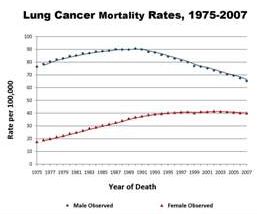Article
Fewer Women Dying of Lung Cancer
Author(s):
For the first time in at least 3 decades, the rate of women dying from lung cancer in the United States is declining

For the first time in at least 3 decades, the rate of women dying from lung cancer in the United States is declining, a trend that may be the start of a long-term decrease reflecting generational changes in cigarette-smoking patterns.
The lung cancer statistics are the most striking data in the Annual Report to the Nation on the Status of Cancer that the National Cancer Institute (NCI) released this week, said Elizabeth Ward, PhD, a co-author of the report who is national vice president for Surveillance and Health Policy Research for the American Cancer Society.
“Lung cancer in women was going up for a long time and then it started to plateau,” Ward said in an interview with OncLive. “It looks like this year we’ve got pretty solid evidence of a downturn.”
The death rate from lung cancer among women declined at an average annual percentage of 0.9% from 2003-2007, the latest figures available, according to the report. The incidence of lung cancer among women also declined, by 0.6%. Nevertheless, lung cancer remains the second-leading cause of cancer in women, after breast cancer, and is still the most lethal.
By contrast, lung cancer death rates have been declining among men for more than a decade.
The statistics reflect trends in cigarette smoking, which peaked among men born in the early 1920s who served in World War II and among women born in the late 1930s, the report noted. “The decrease in lung cancer rates in women that we are seeing now reflects the later uptake of cigarette smoking among women,” the report said.

Researchers expect the rates for women to decline for at least the next 20 years, but they fear an uptick might occur as women born in the 1950s and around 1960 who started smoking in their late teens and early 20s enter the high-risk age groups for cancer onset. “There was a period of time when a number of cigarette brands were really marketing to women,” said Ward. “That was a very popular time for smoking in women.”
Overall, the rate of new cancer diagnoses among men and women declined 0.8% per year across all cancer types between 2003 and 2007, the report said. The death rate from all cancers, which has been dropping since the early 1990s, posted a 1.6% annual decline.
The report, which tracked 15 cancer types, found that the incidence rates among men declined in 5 types, increased in 4 sites, and remained flat in 6 other types. For women, the incidence rose in 5 types, declined in 7 sites, and stayed the same in 3 other types.
Harold Varmus, MD, director of the NCI, said in a press release that the statistics reflect “the enormous complexity of cancer, with different trends for different kinds of cancers, important differences among our diverse people, and different capabilities to prevent, detect, and treat various cancers.”
“Moreover, as our population continues to age, we have an obligation to discover and deliver better ways to control all types of cancers," he said.
Kohler BA, Ward E, McCarthy BJ, et al. Annual report to the nation on the status of cancer, 1975-2007, featuring tumors of the brain and other nervous system. [published online ahead of print March 3, 2011]. J Natl Cancer Inst. doi:10.1093/jnci/djr077.








